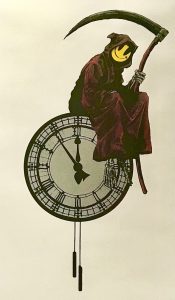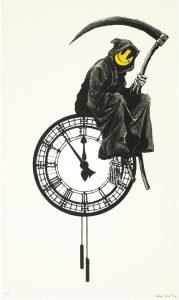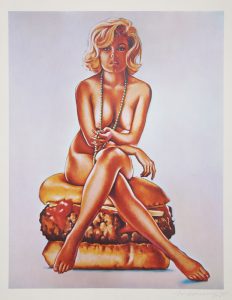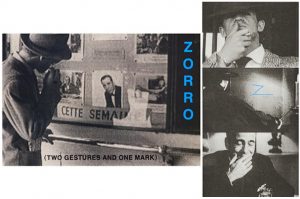
Banksy
Grin Reaper (Red Reaper)
2005
Screenprint
30 3/8 x 19 5/8 in.
Unique Artist Proof (A.P.) outside of the regular edition of 300
Pencil signed, dated and annotated A.P.
*Accompanied with a COA by Pest Control
This week’s Work of the Week – WOW!!! is the Grin Reaper. Only this work is a rare one of a kind unique Artist’s Proof.
There are quite a few differences between this version of Banksy’s Grin Reaper, and the regular edition version. (See photos below). This version of Banksy’s Grin Reaper, is an extremely rare unique one of a kind screenprint.
The differences are:
– The Reaper’s cloak is red, instead of black
– His scythe is red, instead of black, and the blade has metallic silver highlights
– The clock is metallic silver, instead of white
– The Reaper’s bones (skeleton) is also silver instead of white
– There is a matching silver border around the print
– This work is untrimmed, and larger measuring 30 3/8 x 19 5/8 in. (77 x 50 cm)
– The regular edition is 27 1/2 x 17 5/8 in. (70 x 44 cm)
This work is certified authentic by Pest Control, and is even titled the “Red Reaper” on the COA. It is an Artist’s Proof (AP), outside of the edition.
This is a rare, unique, one of a kind print

Unique Artist Proof

Regular Edition of 300
Banksy’s “Grin Reaper” is one of the artist’s most iconic images. Banksy’s original regular edition print was first released in 2005, as an edition of 300 pieces, and existed as a graffiti piece on Old Street, London. The work was originally part of ‘pop up shop’ exhibitions by Banksy.
This screen print by Banksy shows a grim reaper, with a comical twist. The reaper holds his traditional scythe, and he is sitting, casually on the top of a clock. It is five minutes to midnight, presumably the reaper is awaiting for the clock to strike twelve, before enacting his grim duties! However, instead of the usual skeletal features associated with the reaper, his face has been replaced with a bright yellow smiley face.
This piece plays with the boundaries between good and evil, by taking a typical symbol of something ‘bad’ (the reaper) and countering that with something considered to be good… a smiley face. The bringer of Doom, is now perhaps, not so bad after all. Almost welcoming you to your fate.


 Mel Ramos
Mel Ramos Robert Rauschenberg
Robert Rauschenberg John Baldessari
John Baldessari

 Roy Lichtenstein
Roy Lichtenstein Damein Hirst
Damein Hirst